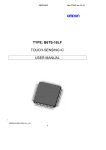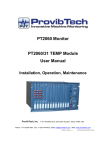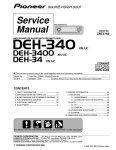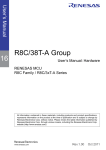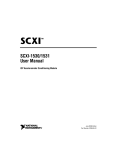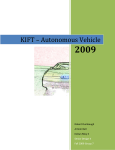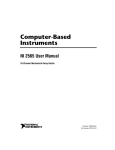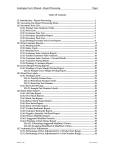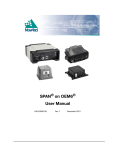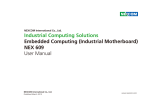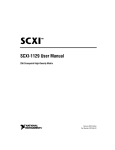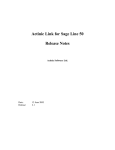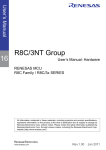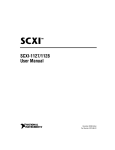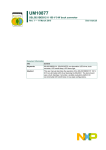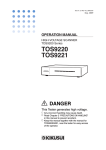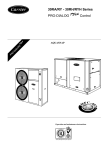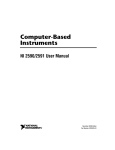Download NI 2501/2503 User Manual - Pdfstream.manualsonline.com
Transcript
Computer-Based Instruments NI 2501/2503 User Manual 24-Channel Two-Wire Multiplexer NI 2501/2503 User Manual July 1998 Edition Part Number 321906B-01 Internet Support E-mail: [email protected] FTP Site: ftp.natinst.com Web Address: http://www.natinst.com Bulletin Board Support BBS United States: 512 794 5422 BBS United Kingdom: 01635 551422 BBS France: 01 48 65 15 59 Fax-on-Demand Support 512 418 1111 Telephone Support (USA) Tel: 512 795 8248 Fax: 512 794 5678 International Offices Australia 03 9879 5166, Austria 0662 45 79 90 0, Belgium 02 757 00 20, Brazil 011 288 3336, Canada (Ontario) 905 785 0085, Canada (Québec) 514 694 8521, Denmark 45 76 26 00, Finland 09 725 725 11, France 01 48 14 24 24, Germany 089 741 31 30, Hong Kong 2645 3186, Israel 03 6120092, Italy 02 413091, Japan 03 5472 2970, Korea 02 596 7456, Mexico 5 520 2635, Netherlands 0348 433466, Norway 32 84 84 00, Singapore 2265886, Spain 91 640 0085, Sweden 08 730 49 70, Switzerland 056 200 51 51, Taiwan 02 377 1200, United Kingdom 01635 523545 National Instruments Corporate Headquarters 6504 Bridge Point Parkway Austin, Texas 78730-5039 USA Tel: 512 794 0100 © Copyright 1998 National Instruments Corporation. All rights reserved. Important Information Warranty The NI 2501 and NI 2503 are warranted against defects in materials and workmanship for a period of one year from the date of shipment, as evidenced by receipts or other documentation. National Instruments will, at its option, repair or replace equipment that proves to be defective during the warranty period. This warranty includes parts and labor. The media on which you receive National Instruments software are warranted not to fail to execute programming instructions, due to defects in materials and workmanship, for a period of 90 days from date of shipment, as evidenced by receipts or other documentation. National Instruments will, at its option, repair or replace software media that do not execute programming instructions if National Instruments receives notice of such defects during the warranty period. National Instruments does not warrant that the operation of the software shall be uninterrupted or error free. A Return Material Authorization (RMA) number must be obtained from the factory and clearly marked on the outside of the package before any equipment will be accepted for warranty work. National Instruments will pay the shipping costs of returning to the owner parts which are covered by warranty. National Instruments believes that the information in this manual is accurate. The document has been carefully reviewed for technical accuracy. In the event that technical or typographical errors exist, National Instruments reserves the right to make changes to subsequent editions of this document without prior notice to holders of this edition. The reader should consult National Instruments if errors are suspected. In no event shall National Instruments be liable for any damages arising out of or related to this document or the information contained in it. EXCEPT AS SPECIFIED HEREIN, NATIONAL INSTRUMENTS MAKES NO WARRANTIES, EXPRESS OR IMPLIED, AND SPECIFICALLY DISCLAIMS ANY WARRANTY OF MERCHANTABILITY OR FITNESS FOR A PARTICULAR PURPOSE. CUSTOMER’S RIGHT TO RECOVER DAMAGES CAUSED BY FAULT OR NEGLIGENCE ON THE PART OF NATIONAL INSTRUMENTS SHALL BE LIMITED TO THE AMOUNT THERETOFORE PAID BY THE CUSTOMER. NATIONAL INSTRUMENTS WILL NOT BE LIABLE FOR DAMAGES RESULTING FROM LOSS OF DATA, PROFITS, USE OF PRODUCTS, OR INCIDENTAL OR CONSEQUENTIAL DAMAGES, EVEN IF ADVISED OF THE POSSIBILITY THEREOF. This limitation of the liability of National Instruments will apply regardless of the form of action, whether in contract or tort, including negligence. Any action against National Instruments must be brought within one year after the cause of action accrues. National Instruments shall not be liable for any delay in performance due to causes beyond its reasonable control. The warranty provided herein does not cover damages, defects, malfunctions, or service failures caused by owner’s failure to follow the National Instruments installation, operation, or maintenance instructions; owner’s modification of the product; owner’s abuse, misuse, or negligent acts; and power failure or surges, fire, flood, accident, actions of third parties, or other events outside reasonable control. Copyright Under the copyright laws, this publication may not be reproduced or transmitted in any form, electronic or mechanical, including photocopying, recording, storing in an information retrieval system, or translating, in whole or in part, without the prior written consent of National Instruments Corporation. Trademarks CVI™, LabVIEW™, NI-SWITCH™, and PXI™ are trademarks of National Instruments Corporation. Product and company names listed are trademarks or trade names of their respective companies. WARNING REGARDING MEDICAL AND CLINICAL USE OF NATIONAL INSTRUMENTS PRODUCTS National Instruments products are not designed with components and testing intended to ensure a level of reliability suitable for use in treatment and diagnosis of humans. Applications of National Instruments products involving medical or clinical treatment can create a potential for accidental injury caused by product failure, or by errors on the part of the user or application designer. Any use or application of National Instruments products for or involving medical or clinical treatment must be performed by properly trained and qualified medical personnel, and all traditional medical safeguards, equipment, and procedures that are appropriate in the particular situation to prevent serious injury or death should always continue to be used when National Instruments products are being used. National Instruments products are NOT intended to be a substitute for any form of established process, procedure, or equipment used to monitor or safeguard human health and safety in medical or clinical treatment. Compliance FCC/DOC Radio Frequency Interference Class A Compliance This equipment generates and uses radio frequency energy and, if not installed and used in strict accordance with the instructions in this manual, may cause interference to radio and television reception. Classification requirements are the same for the Federal Communications Commission (FCC) and the Canadian Department of Communications (DOC). This equipment has been tested and found to comply with the following two regulatory agencies: Federal Communications Commission This equipment has been tested and found to comply with the limits for a Class A digital device, pursuant to part 15 of the FCC Rules. These limits are designed to provide reasonable protection against harmful interference when the equipment is operated in a commercial environment. This equipment generates, uses, and can radiate radio frequency energy and, if not installed and used in accordance with the instruction manual, may cause harmful interference to radio communications. Operation of this equipment in a residential area is likely to cause harmful interference in which case the user will be required to correct the interference at his own expense. Notices to User: Changes or modifications not expressly approved by National Instruments could void the user’s authority to operate the equipment under the FCC Rules. This device complies with the FCC rules only if used with shielded interface cables of suitable quality and construction. National Instruments used such cables to test this device and provides them for sale to the user. The use of inferior or nonshielded interface cables could void the user’s authority to operate the equipment under the FCC rules. If necessary, consult National Instruments or an experienced radio/television technician for additional suggestions. The following booklet prepared by the FCC may also be helpful: Interference to Home Electronic Entertainment Equipment Handbook. This booklet is available from the U.S. Government Printing Office, Washington, DC 20402. Canadian Department of Communications This Class A digital apparatus meets all requirements of the Canadian Interference-Causing Equipment Regulations. Cet appareil numérique de la classe A respecte toutes les exigences du Règlement sur le matériel brouilleur du Canada. Conventions The following conventions are used in this manual. <> Angle brackets containing numbers separated by an ellipsis represent a range of values associated with a port, bit, or signal name (for example, CH<0..7> stands for the signals CH0 through CH7). This icon to the left of bold italicized text denotes a note, which alerts you to important information. ! This icon to the left of bold italicized text denotes a caution, which advises you of precautions to take to avoid injury, data loss, or a system crash. This icon to the left of bold italicized text denotes a warning, which advises you of precautions to take to avoid being electrically shocked. bold italic Bold italic text denotes a note, caution, or warning. italic Italic text denotes variables, emphasis, a cross reference, or an introduction to a key concept. This font also denotes text from which you supply the appropriate word or value, as in CHx. Contents Chapter 1 Routing Signals with Your NI 2501/2503 About the NI 2501/2503 ................................................................................................1-1 Analog Bus ......................................................................................................1-2 Triggers............................................................................................................1-2 Cold-Junction Sensor Channel ........................................................................1-3 NI 2501 Amplifier ...........................................................................................1-3 Connecting Signals ........................................................................................................1-4 Front Connector...............................................................................................1-4 Contact Protection..........................................................................................................1-10 Terminal Blocks.............................................................................................................1-10 Software Choices ...........................................................................................................1-10 NI-SWITCH Driver Software .........................................................................1-10 National Instruments Application Software ....................................................1-11 Third Party Software .......................................................................................1-11 Chapter 2 NI 2501/2503 Operation Functional Overview......................................................................................................2-1 Multiplexer.....................................................................................................................2-4 Two-Wire Mode ..............................................................................................2-4 One-Wire Mode...............................................................................................2-4 Four-Wire Mode..............................................................................................2-5 Matrix Mode....................................................................................................2-5 Switch Control Circuitry................................................................................................2-5 Random Scanning ..........................................................................................................2-5 PXI Interface..................................................................................................................2-6 Triggers............................................................................................................2-6 External Trigger Input.......................................................................2-6 Scanner Advanced.............................................................................2-7 Modes................................................................................................2-7 Initiating Scanning...........................................................................................2-8 Multicard Triggering .......................................................................................2-8 Appendix A Specifications © National Instruments Corporation vii NI 2501/2503 User Manual Contents Appendix B Accessories Appendix C Customizing Your Card Appendix D Architecture Drawings Appendix E Common Questions Appendix F Customer Communication Glossary Index Figures Figure 1-1. Figure 1-2. Figure 1-3. Figure 1-4. Front Connector Pinout Assignments for Two-Wire Mode ................. 1-5 Front Connector Pinout Assignments for One-Wire Mode .................. 1-6 Front Connector Pinout Assignments for Four-Wire Mode ................. 1-7 Front Connector Pinout Assignments to Create a 6 x 4 Matrix ............ 1-8 Figure 2-1. Figure 2-2. NI 2501 Module Block Diagram .......................................................... 2-2 NI 2503 Module Block Diagram .......................................................... 2-3 Figure C-1. Bent and Trimmed Resistor .................................................................. C-2 Figure D-1. Figure D-2. NI 2501 Switch Architecture ................................................................ D-2 NI 2503 Switch Architecture ................................................................ D-3 Tables Table 1-1. NI 2501/2503 User Manual Front Connector Signal Description .................................................... 1-9 viii © National Instruments Corporation Routing Signals with Your NI 2501/2503 1 This manual describes the electrical and mechanical aspects of the NI 2501 FET multiplexer and the NI 2503 mechanical relay multiplexer and contains information concerning their installation and operation. This manual uses the term NI 2501/2503 whenever information applies to both instruments. About the NI 2501/2503 This section summarizes the features and operation of the NI 2501/2503 switch card. Refer to Chapter 2, NI 2501/2503 Operation, for more complete details. In addition, refer to Appendix A, Specifications, for detailed specifications of the two switch cards. The NI 2501 is a FET switch card, and the NI 2503 is an armature relay switch card. Each consists of a 24 x 1 two-wire multiplexer in PXI/Compact PCI format. You can take advantage of the switch card’s flexibility to handle a wide variety of test systems through the use of various accessories and software configurations. You can use the National Instruments NI-SWITCH software included with your kit to configure and operate the NI 2501/2503 switch card. The NI 2501/2503 can also operate as two 12 x 1 or four 6 x 1 two-wire multiplexers. You can use software-configurable switches to configure the switch card as a 48 x 1 one-wire multiplexer for making large numbers of common referenced measurements. In addition, the NI 2501/2503 can operate as a 12 x 1 four-wire multiplexer to handle resistive measurements, such as thermistors or RTDs. Finally, you can use a National Instruments TB-2606 terminal block to further configure the NI 2501/2503 as a 6 x 4 two-wire matrix. The Connecting Signals section of this chapter contains more information on one-wire, two-wire, four-wire, and matrix configurations, and includes diagrams of the pinout connections to make. © National Instruments Corporation 1-1 NI 2501/2503 User Manual Chapter 1 Routing Signals with Your NI 2501/2503 Refer to Appendix B, Accessories, for more information on terminal blocks you can order from National Instruments. You can also use multiple NI 2501/2503 cards together to expand the size of the multiplexer or matrix. For example, you can connect two cards to create a 48 x 1 two-wire multiplexer or a 12 x 4 two-wire matrix. ! Caution The maximum voltage is different for the NI 2501 and NI 2503 switch cards. If you intend to use more than one type of card, be sure you do not exceed the maximum voltage of any card in your system. Refer to Appendix A, Specifications, for information. Analog Bus The NI 2501/2503 works with a four-wire analog bus. You connect the analog bus to the switch card through its main front-panel connector. You can use the analog bus to simplify connecting multiple cards to an instrument such as a digital multimeter (DMM). This bus makes it possible to create large systems using multiple switch cards. For example, if you have two NI 2501/2503 cards—or one of each—in two adjacent slots, you can connect them through the analog bus and create a 48 x 1 two-wire multiplexer. With this flexibility, you keep the wiring of the modules to a minimum while you create large switching solutions. In such cases, the scanning architecture uses some of the PXI trigger lines for synchronization and delivers full access to all of the scanning features for the cards. The National Instruments software you receive with the NI 2501/2503 handles the complexity of programming the cards. Triggers Two triggers are used to handshake the NI 2501/2503 switch with PXI instruments or other external instruments. The Scanner Advanced trigger indicates when the card has closed all the necessary switches for the next scan and the switches have settled, or debounced. This trigger is typically wired to a measurement device, such as a DMM, which is configured to take a reading when it receives the trigger. The External Trigger Input trigger is sourced by another instrument, such as the DMM, and causes the NI 2501/2503 to advance to the next entry in the scan list. The triggers can be routed to the front connector of the NI 2501/2503, to any of the PXI TTL triggers, or to the PXI star trigger. If no external trigger input is available, you can have the software trigger the NI 2501/2503 to advance to the next entry in the scan list. NI 2501/2503 User Manual 1-2 © National Instruments Corporation Chapter 1 Routing Signals with Your NI 2501/2503 Refer to Chapter 2, NI 2501/2503 Operation, for more information on triggers. Cold-Junction Sensor Channel For low-voltage measurements, such as those provided by thermocouples, the NI 2503 has very low thermal offset—less than 2 µV—to ensure accurate measurements. For cold-junction compensation when switching thermocouples, the NI 2501/2503 has a dedicated channel for a temperature sensor. The National Instruments TB-2605 and TBX-68S terminal blocks both have onboard temperature sensors that connect to the dedicated cold-junction sensor channel. NI 2501 Amplifier The NI 2501 has an amplifier with a gain of 1. This amplifier can be switched in-line before the COM0 signal and the AB0 signal. The amplifier helps to decrease the settling time of the FET switch. The amplifier’s high impedance isolates the FET from the resistance, capacitance, and inductance in the external wiring. This isolation decreases the resistance/capacitance time constant seen by the FET, which improves settling time. The amplifier has an offset that should be calibrated for more accurate measurements. The calibration data can be stored into and retrieved from the EEPROM on the board. The software you received with your switch card includes API function calls to retrieve and store calibration data. When the amplifier is used, the switch card becomes directional, where CHx is for signal inputs and COM0 or AB0 are for signal outputs. The NI 2501 also has an amplifier in the CJS0+ to COM0+ signal path. This amplifier in the cold-junction sensor signal path is used to improve settling time performance. It prevents the impedance of the cold-junction sensor from increasing the settling time when switching the CJS channel. As a result, when scanning thermocouples, the settling time for the cold-junction sensor channel should be about the same as for the channels with the thermocouples. © National Instruments Corporation 1-3 NI 2501/2503 User Manual Chapter 1 Routing Signals with Your NI 2501/2503 Connecting Signals This section describes the signal connections to the NI 2501/2503 module via the module front connector. This section also includes specifications and connection instructions for the signals on the NI 2501/2503 module connectors. ! Caution Static electricity is a major cause of component failure. To prevent damage to the electrical components in the module, observe antistatic precautions whenever removing a module from the chassis or whenever working on a module. Front Connector The pinout assignments for the NI 2501/2503 front connector vary depending on the wiring mode you use. The following four diagrams show the pin assignments for two-wire mode, one-wire mode, four-wire mode, and matrix mode, respectively. Two-wire mode is shown first because it is the most common configuration. Table 1-1, following the diagrams, describes the connector signals. For more information on the wiring modes, refer to the Multiplexer section in Chapter 2, NI 2501/2503 Operation. Warning Any connections that exceed the maximum settings for the NI 2501/2503 can result in an electrical shock hazard and damage to the NI 2501/2503 module and any or all of the boards connected to the PXI backplane. National Instruments is NOT liable for any damages or injuries resulting from exceeding maximum voltage ratings. Refer to Appendix A, Specifications, for information. NI 2501/2503 User Manual 1-4 © National Instruments Corporation Chapter 1 CJS0– CH0– CH1– CH2– CH3– CH4– CH5– COM0– COM1– CH6– CH7– CH8– 1 1_WIRE_LO_REF CH9– CH10– CH11– AB0– AB1– CH12– CH13– CH14– CH15– CH16– CH17– COM2– COM3– +5 V GND CH18– CH19– CH20– CH21– CH22– CH23– 1 34 33 32 31 30 29 28 27 26 25 24 23 22 21 20 19 18 17 16 15 14 13 12 11 10 9 8 7 6 5 4 3 2 1 Routing Signals with Your NI 2501/2503 68 67 66 65 64 63 62 61 60 59 58 57 56 55 54 53 52 51 50 49 48 47 46 45 44 43 42 41 40 39 38 37 36 35 CJS0+ CH0+ CH1+ CH2+ CH3+ CH4+ CH5+ COM0+ COM1+ CH6+ CH7+ CH8+ GND CH9+ CH10+ CH11+ AB0+ AB1+ CH12+ CH13+ CH14+ CH15+ CH16+ CH17+ COM2+ COM3+ SCAN_ADV EXT_TRIG_IN CH18+ CH19+ CH20+ CH21+ CH22+ CH23+ not used in two-wire mode Figure 1-1. Front Connector Pinout Assignments for Two-Wire Mode © National Instruments Corporation 1-5 NI 2501/2503 User Manual Chapter 1 Routing Signals with Your NI 2501/2503 1 CJS– CH24 CH25 CH26 CH27 CH28 CH29 COM0– COM1– (CH30–CH35)1 CH30 CH31 CH32 1_WIRE_LO_REF CH33 CH34 CH35 AB0– 1 AB1– CH36 CH37 CH38 CH39 CH40 CH41 COM2– (CH36–CH41)1 1 COM3– (CH42–CH48) +5 V GND CH42 CH43 CH44 CH45 CH46 CH47 34 33 32 31 30 29 28 27 26 25 24 23 22 21 20 19 18 17 16 15 14 13 12 11 10 9 8 7 6 5 4 3 2 1 68 67 66 65 64 63 62 61 60 59 58 57 56 55 54 53 52 51 50 49 48 47 46 45 44 43 42 41 40 39 38 37 36 35 1 CJS+ CH0 CH1 CH2 CH3 CH4 CH5 COM0+ COM1+ (CH6–CH11)1 CH6 CH7 CH8 GND CH9 CH10 CH11 AB0+ 1 AB1+ CH12 CH13 CH14 CH15 CH16 CH17 COM2+ (CH12–CH17)1 1 COM3+ (CH18–CH23) SCAN_ADV EXT_TRIG_IN CH18 CH19 CH20 CH21 CH22 CH23 1 not used in one-wire mode Figure 1-2. Front Connector Pinout Assignments for One-Wire Mode NI 2501/2503 User Manual 1-6 © National Instruments Corporation Chapter 1 1 CJS– CH0A– CH1A– CH2A– CH3A– CH4A– CH5A– COM0A– COM1A– CH6A– CH7A– CH8A– 1 1_WIRE_LO_REF CH9A– CH10A– CH11A– AB0A– AB0B– CH0B– CH1B– CH2B– CH3B– CH4B– CH5B– COM0B– COM1B– +5 V GND CH6B– CH7B– CH8B– CH9B– CH10B– CH11B– 34 33 32 31 30 29 28 27 26 25 24 23 22 21 20 19 18 17 16 15 14 13 12 11 10 9 8 7 6 5 4 3 2 1 Routing Signals with Your NI 2501/2503 68 67 66 65 64 63 62 61 60 59 58 57 56 55 54 53 52 51 50 49 48 47 46 45 44 43 42 41 40 39 38 37 36 35 1 CJS+ CH0A+ CH1A+ CH2A+ CH3A+ CH4A+ CH5A+ COM0A+ COM1A+ CH6A+ CH7A+ CH8A+ GND CH9A+ CH10A+ CH11A+ AB0A+ AB0B+ CH0B+ CH1B+ CH2B+ CH3B+ CH4B+ CH5B+ COM0B+ COM1B+ SCAN_ADV EXT_TRIG_IN CH6B+ CH7B+ CH8B+ CH9B+ CH10B+ CH11B+ 1 not used in four-wire mode Figure 1-3. Front Connector Pinout Assignments for Four-Wire Mode © National Instruments Corporation 1-7 NI 2501/2503 User Manual Chapter 1 Routing Signals with Your NI 2501/2503 1 CJS– COL0– COL1– COL2– COL3– COL4– COL5– ROW0– ROW1– COL0– COL1– COL2– 1_WIRE_LO_REF1 COL3– COL4– COL5– AB0– (ROW0–) AB1– (ROW2–) COL0– COL1– COL2– COL3– COL4– COL5– ROW2– ROW3– +5 V GND COL0– COL1– COL2– COL3– COL4– COL5– 34 33 32 31 30 29 28 27 26 25 24 23 22 21 20 19 18 17 16 15 14 13 12 11 10 9 8 7 6 5 4 3 2 1 68 67 66 65 64 63 62 61 60 59 58 57 56 55 54 53 52 51 50 49 48 47 46 45 44 43 42 41 40 39 38 37 36 35 1 CJS+ COL0+ COL1+ COL2+ COL3+ COL4+ COL5+ ROW0+ ROW1+ COL0+ COL1+ COL2+ GND COL3+ COL4+ COL5+ AB0+ (ROW0+) AB1+ (ROW2+) COL0+ COL1+ COL2+ COL3+ COL4+ COL5+ ROW2+ ROW3+ SCAN_ADV EXT_TRIG_IN COL0+ COL1+ COL2+ COL3+ COL4+ COL5+ 1 not used in matrix mode Figure 1-4. Front Connector Pinout Assignments to Create a 6 x 4 Matrix For matrix mode, connect all pins with the same name together external to the switch card. The National Instruments TB-2606 terminal block connects the necessary pins to create the 6 x 4 matrix. NI 2501/2503 User Manual 1-8 © National Instruments Corporation Chapter 1 Routing Signals with Your NI 2501/2503 Table 1-1. Front Connector Signal Description Signal Name Type Description +5 V Output +5 VDC Source—Powers the temperature sensor on the terminal block. 0.2 mA of source protected by a resettable poly fuse. GND Output Ground CJS± Input Cold-junction Temperature Sensor Input— Connects to the temperature sensor of the terminal block. 1_WIRE_LO_REF Input The common reference signal used in one-wire mode. EXT_TRIG_IN Input External Trigger Input—Trigger from an instrument to advance the switch card to the next scan entry. SCAN_ADV Output Scanner Advanced—Trigger to an instrument that indicated the switch card has advanced to the next scan and relays are debounced. CH<0..47> (one wire) CH<0..23>± (two wire) CH<0..11>A± (four wire) CH<0..11>B± (four wire) Input/Output Channels—Where signals are connected to the switch card. CHx+ and CHx– are switched together. COM0± (one wire) COM<0..3>± (two wire) COM<0..1>A± (four wire) COM<0..1>B± (four wire) Input/Output Common—The common for each bank. AB0± (one wire) AB<0..1>± (two wire) AB0A± (four wire) AB0B± (four wire) Input/Output Analog Bus—Used to wire multiple switch cards to an instrument such as a DMM. COL<0..5>± Input/Output Columns—Where signals are connected to the switch card. The card behaves as a matrix when proper external wiring is added. ROW<0..3>± Input/Output Rows—Where signals are connected to the switch card. In matrix configuration any row can be connected to any column. © National Instruments Corporation 1-9 NI 2501/2503 User Manual Chapter 1 Routing Signals with Your NI 2501/2503 Contact Protection ! Caution When inductive loads are connected to the relays, a large counter electromotive force may occur at relay switching time due to the energy stored in the inductive load. These flyback voltages can severely damage the relay contacts and greatly shorten the life of the relay. It is best to limit flyback voltages at your inductive load by installing a flyback diode for DC loads or a movistor for AC loads. Terminal Blocks Several terminal blocks with screw terminals are available for easy signal connection to the NI 2501/2503 inputs. Refer to Appendix B, Accessories. Software Choices You have several options to choose from when programming your National Instruments switch card. You can use the NI-SWITCH driver software, or National Instruments application software. NI-SWITCH Driver Software The NI-SWITCH instrument driver is an Intelligent Virtual Instrument (IVI) compliant instrument driver that is bundled with NI-SWITCH cards at no cost. NI-SWITCH features a set of operations and attributes that exercise all the functionality of the switching hardware, including configuration, opening/closing, and scanning. In addition, NI-SWITCH comes with an interactive soft front panel and online documentation. NI-SWITCH eliminates the need to understand complex register programming and interrupt handling in the Microsoft operating systems, and frees you to focus on creating your test system. NI 2501/2503 User Manual 1-10 © National Instruments Corporation Chapter 1 Routing Signals with Your NI 2501/2503 National Instruments Application Software LabVIEW and LabWindows/CVI are innovative program development software packages for data acquisition and control applications. LabVIEW uses graphical programming, whereas LabWindows/CVI enhances traditional programming languages. Both packages include extensive libraries for data acquisition, instrument control, data analysis, and graphical data presentation. Using LabVIEW or LabWindows/CVI can significantly reduce the development time for your data acquisition and control application. LabVIEW features interactive graphics, a state-of-the-art user interface, and a powerful graphical programming language. The LabVIEW NI-SWITCH VI Library, a series of virtual instruments (VIs) for using LabVIEW with National Instruments switch hardware, is included with the NI-SWITCH driver. LabWindows/CVI features interactive graphics, a state-of-the-art user interface, and uses the ANSI standard C programming language. The LabWindows/CVI NI-SWITCH Library, a series of functions for using LabWindows/CVI with National Instruments switch hardware, is included with the NI-SWITCH driver. Third Party Software The NI-SWITCH instrument driver also includes support files for Microsoft Visual C++ and Microsoft Visual Basic. Please see the NI-SWITCH readme file for version support information. © National Instruments Corporation 1-11 NI 2501/2503 User Manual NI 2501/2503 Operation 2 This chapter contains a functional overview of the NI 2501/2503 module and explains the operation of each functional unit making up the NI 2501/2503 module. Functional Overview The block diagrams on the following pages illustrate the key functional components of the switch card modules. Figure 2-1 shows the NI 2501 and Figure 2-2 shows the NI 2503. The major components of the NI 2501/2503 modules are as follows: • Multiplexer • Relay/FET switch control circuitry • Random scanning • PXIbus interface • Triggers © National Instruments Corporation 2-1 NI 2501/2503 User Manual Chapter 2 NI 2501/2503 Operation Analog Bus0 Com0 One Wire / Two Wire Select FET Mux FET Mux CH0 CH5 AISENSE Unity Gain Amplifier Select Cold Junction Sensor Com1 PXIbus Connector PXI Interface FET Mux CH11 Scan Memory Com2 CH12 CH17 Com3 FET Switch Control Analog Bus1 FET Mux Front Connector CH6 FET Mux CH18 Triggers CH23 Figure 2-1. NI 2501 Module Block Diagram NI 2501/2503 User Manual 2-2 © National Instruments Corporation Chapter 2 NI 2501/2503 Operation Analog Bus0 Com0 One Wire / Two Wire Select Relay Mux Relay Mux CH0 CH5 AISENSE Cold Junction Sensor Com1 PXIbus Connector PXI Interface Relay Mux CH11 Scan Memory Com2 CH12 CH17 Relay Control Analog Bus1 Relay Mux Front Connector CH6 Com3 Relay Mux CH18 Triggers CH23 Figure 2-2. NI 2503 Module Block Diagram © National Instruments Corporation 2-3 NI 2501/2503 User Manual Chapter 2 NI 2501/2503 Operation Multiplexer The relay multiplexer consists of four banks of six channels. The switches for the six channels in each bank connect the channels to a common output for each bank. • Bank 0 consists of Channels 0–5 and Common 0. • Bank 1 consists of Channels 6–11 and Common 1. • Bank 2 consists of Channels 12–17 and Common 2. • Bank 3 consists of Channels 18–23 and Common 3. Each channel connects to the corresponding bank common by closing its relay/FET switch. You can have multiple channels connected to the bank common at the same time. Bank connection relay/FET switches can combine the commons of the four banks. See Appendix D, Architecture Drawings, for illustrations of the NI 2501 and NI 2503 architecture. The NI 2503 relays are single-side stable. When power is removed from the relay coil, the relay returns to its de-energized state. The de-energized state opens all the relays, disconnecting the device from external inputs and outputs. See Figures 1-1 through 1-4 in Chapter 1, Routing Signals with Your NI 2501/2503, for the pin names used for the different modes of operation. Different names are used for the pin assignments in the different modes to better reflect the operation in the different modes and to simplify the task of wiring. Two-Wire Mode Two-wire mode is the default and most common configuration for the NI 2501/2503 switch cards. The CHx+ and CHx– channels are switched together to the COMx+ and COMx– signals for the corresponding bank. One-Wire Mode One-wire mode doubles the channel count of what is available in two-wire mode. However, the signals connected to the switch card need a common reference. For one-wire measurements, Bank 0 includes extra relays between the multiplexed channel relays and COM0. The 1WIRE relay switch connects COM0– to the 1-Wire Lo Ref signal. The HLSELECT relay connects COM0+ to either CHx+ or CHx–. The de-energized states for these relays configure the device for two-wire measurements. NI 2501/2503 User Manual 2-4 © National Instruments Corporation Chapter 2 NI 2501/2503 Operation Four-Wire Mode Four-wire mode is typically used for resistance measurements. In this mode, CHxA+, CHxA–, CHxB+, and CHxB–, are switched together to COMxA+, COMxA–, COMxB+, and COMxB–. Matrix Mode By adding some external wiring, you can configure the switch card as a two-wire 6 x 4 crosspoint matrix. (See Figure 1-4 in Chapter 1.) The TB-2606 terminal block simplifies your wiring task by connecting the necessary pins on the switch card’s front connector to create the 6 x 4 matrix. In the matrix configuration, you can connect any ROWx signal to any COLx signal. Switch Control Circuitry The switch control circuitry (SCC) is responsible for opening and closing FET switches on the NI 2501 or relays on the NI 2503. You can load commands for the SCC into memory storage using the driver software you received with your kit. Consult the online help or your software documentation for specific information on the appropriate commands. There are two reasons for storing the commands in memory before the SCC can process them: • The operate/release time for the NI 2503 is 3 to 5 ms. Using memory storage, the software can send multiple commands to the SCC without having to wait for a relay action to complete. • The memory is used to store a scan list necessary for hardware random scanning. Random Scanning The NI 2501/2503 can perform random scanning. In random scanning, the switch card can scan the channels in any order. The scan list is downloaded to onboard memory. Commands in the scan list can: • Open or close relays • Wait for an external trigger © National Instruments Corporation 2-5 NI 2501/2503 User Manual Chapter 2 NI 2501/2503 Operation • Generate a scanner advanced trigger • Generate a breakpoint interrupt You can use the driver software to configure the switch card for continuous or one-time scanning. In continuous scanning, the switch card cycles through the scan list until you disable scanning. For one-time scanning, the switch card cycles through the scan list only once. You can also use software commands to clear the scan list or reset it to the beginning at any time. The onboard control logic for the NI 2501/2503 switch card gives you direct access to open and close the relays, and also the capability to download up to 1024 random scanning instructions. The software included with the card automatically configures the NI 2501/2503 and downloads the scan list to hardware for you. The scan list itself downloads directly into the memory of the card to deliver the fastest scan possible with no controller intervention. You can configure the switch card to process the scan list once or to continuously loop through the scan list. When configured to operate as a single switch card with multiple multiplexers—such as four 6 x 1 two-wire multiplexers—the scan architecture makes it possible for each multiplexer to have its own parallel scan list (which must be triggered together). Also, if the switch card is configured as a matrix, the scanning architecture scans the matrix through a series of user-definable states. PXI Interface The NI 2501/2503 switch card has a PXI interface through which you can use your driver software to configure and control the card. The NI 2501/2503 takes advantage of PXI features. It uses the PXI TTL triggers to synchronize scanning with a measurement device such as a National Instruments NI-4060 PXI digital multimeter (DMM). Triggers External Trigger Input The NI 2501/2503 can use an external trigger input to advance between scan setups in a scan list. Using the driver software, you can configure the switch card to route the external trigger from any of the PXI TTL trigger lines, the PXI star trigger, or the EXT TRIG IN pin on the front connector. Alternatively, you can use a software command to trigger the switch card. NI 2501/2503 User Manual 2-6 © National Instruments Corporation Chapter 2 NI 2501/2503 Operation Routing the external trigger from the front connector to the PXI trigger lines gives you the capability to trigger multiple switch cards with only one board connected to the external trigger from the measurement device. All external trigger lines are compatible with TTL voltage levels and are edge sensitive. The external trigger from the front connector requires a minimum pulse width of 500 ns. The line has a low pass filter to prevent false triggering. The minimum pulse width from the PXI TTL triggers and PXI star trigger is 70 ns. Scanner Advanced The NI 2501/2503 can generate a scanner advanced trigger to indicate when the switch card is set up and ready to take measurements. Using the driver software, you can configure the switch card to route the scanner advanced (SCANADV) trigger to any PXI TTL trigger line, the PXI star trigger, or the SCAN_ADV pin on the front connector. You can configure the switch card to generate the SCANADV trigger when a relay has settled (or debounced). All SCANADV trigger lines are compatible with TTL voltage levels. Because the NI 2501/2503 has open collector drives on the PXI TTL trigger lines, you can have multiple switch cards using the same trigger line in the multicard SCANADV mode. Modes SCANADV has two modes of operation. In its default mode, the SCANADV trigger asserts for 1 µs after the relay has debounced. You can also configure the switch card for handshaking mode, in which the SCANADV trigger goes high after a relay settles, and the SCANADV trigger goes low after the external trigger input asserts. Use this handshaking mode for multicard scanning. Note The NI 2501/2503 ignores external triggers when it is not in a wait-for-trigger state while scanning. © National Instruments Corporation 2-7 NI 2501/2503 User Manual Chapter 2 NI 2501/2503 Operation Initiating Scanning When you use the NI 2501/2503 to initiate a scan, make sure the measurement device is armed (waiting for trigger) before enabling scanning on the switch card. Enabling scanning causes the first switch(es) in the scan list to close and generates a scanner advanced trigger after the relay/FET switches have settled or debounced. When you use the measurement device to initiate a scan, make sure scanning is enabled on the NI 2501/2503 before the measurement device starts to take measurements. This ensures that the switch card has the correct signal routed and that the switch card is waiting for an external trigger from the measurement device. Always configure the triggers in a system before configuring the measurement device or the NI 2501/2503 for scanning. When triggers are configured, a state change or pulse could occur on the trigger line. This is also possible when you reset the switch card. Multicard Triggering You can use multiple NI 2501/2503 switch cards together in conjunction with an instrument such as a DMM. In multiple switch-card systems, be sure to identify one switch card as the master switch card. All other switch cards for the system are identified as slave switch cards. The master switch card can route an external trigger from the front connector to a PXI backplane trigger. In addition, the master switch card can route the SCANADV trigger from the PXI backplane to the front connector. This functionality makes it possible to wire external triggers from/to only one switch card in the system, which simplifies the wiring scheme. For more information, refer to the NI-SWITCH Software User Manual. NI 2501/2503 User Manual 2-8 © National Instruments Corporation A Specifications This appendix lists the specifications for the NI 2501 and NI 2503 switch cards. These specifications are typical at 25° C unless otherwise noted. NI 2501 Input Characteristics Number of Channels .............................. 24 Maximum Working Voltage .................. ± 10 VDC from chassis ground Overvoltage Protection Signals CH<0..23>, COM<0..3> Powered on or off .................... ± 25 VDC Signals AB<0..1> Powered on .............................. ± 25 VDC Powered off.............................. ± 15 VDC FET Switch On Resistance Typical ............................................ 50 Ω Max @ 25° C.................................. 85 Ω Max @ 85° C.................................. 100 Ω Total Signal Path Resistance (Channel x to Analog Bus x) Typical ............................................ 1650 Ω Maximum........................................ 1900 Ω Total Signal Path Resistance (Channel x to Common x) Typical ............................................ 1900 Ω Maximum........................................ 2150 Ω © National Instruments Corporation A-1 NI 2501/2503 User Manual Appendix A Specifications for NI 2501 Transfer Characteristics Channel Amplifier (Unity Gain) Offset Voltage (Differential) ..................1.2 mV max Cold-Junction Sensor Channel Amplifier (Unity Gain) Offset Voltage Maximum ........................................60 µV Frequency Bandwidth (50 Ω source, 1 MΩ 25 pF load) –3 dB ...............................................400 KHz –10 dB .............................................1 MHz Channel to Channel Crosstalk/Isolation ..................................50 dB Dynamic Characteristics Operating Speed Typical.............................................25,000 cycles/s Maximum ........................................250,000 cycles/s Settling Time (+5 V to –5 V Step) 6 in. AB connector to PXI-MIO 0.012% Accuracy With output buffer selected ......8.5 µs Without output buffer...............9.0 µs 0.006% Accuracy With output buffer selected ......10 µs Without output buffer...............11.5 µs 0.0015% Accuracy With output buffer selected ......16 µs Without output buffer...............18 µs Settling Time (+5 V to –5 V Step) 3 m cable to PXI-MIO 0.012% Accuracy With output buffer selected ......21 µs Without output buffer...............45 µs NI 2501/2503 User Manual A-2 © National Instruments Corporation Appendix A Specifications for NI 2501 0.006% Accuracy With output buffer selected ..... 30 µs Without output buffer .............. 60 µs 0.0015% Accuracy With output buffer selected ..... 80 µs Without output buffer .............. 160 µs Note Settling time is greatly affected by the external wiring to the switch card. You can improve the settling time by minimizing the wiring from the analog bus connection to the measurement device. PXI Bus Interface Slave PXI Trigger Bus Trigger Lines.......................................... 8 Star Trigger ............................................ 1 Power Requirement +5 V Typical ............................................ 300 mA +12 V Typical ............................................ 30 mA –12 V Typical ............................................ 30 mA Physical Dimensions............................................. 10 by 16 cm (3.9 by 6.3 in.) Weight .................................................... 0.254 kg (0.56 lb.) I/O Connector......................................... 68-pin male SCSI © National Instruments Corporation A-3 NI 2501/2503 User Manual Appendix A Specifications for NI 2501 Environment Operating Temperature ........................ 0° to 50° C Storage Temperature............................ –55° to 150° C Relative Humidity...................................5% to 90% non-condensing Shock and Vibration Functional Shock MIL-T-28800E Class 3 (30 g half-sine shock pulse) Also meets IEC 60068-2-27 Random Vibration MIL-T-28800E, MIL-STD-810E Category 1 Operational ...............................5 to 500 Hz, 0.3 grms Non-operational........................5 to 500 Hz, 2.4 grms Certifications and Compliances CE Mark Compliance This product meets applicable EU directives as follows: Safety Isolation................................low-voltage safety, EN 61010-1:1993 EMC Directive Immunity ..................................EN 50082-1:1992 Emissions .................................EN 55011:1991, Group 1 Class A at 10 m NI 2501/2503 User Manual A-4 © National Instruments Corporation Appendix A Specifications for NI 2503 NI 2503 Input Characteristics Number of Relays Available as Channels ............................................ 24 Common Mode Voltage Channel to Channel......................... 30 Vrms/60 VDC Channel to Earth ............................. 30 Vrms/60 VDC Maximum Allowed Voltage—Differential Mode or Single ended AC ................................................... 30 Vrms DC ................................................... 60 VDC Maximum Switching Capacity—Differential Mode or Single ended DC ................................................... 1 A @ 30 VDC Maximum Switching Power per Differential Channel or Single ended..... 60 VA, 30 W Contact on Resistance (Initial)............... 100 mΩ Contact Material..................................... Gold-clad Silver Alloy Transfer Characteristics Thermal E.M.F. (Differential)................ <2 µV Maximum Frequency Bandwidth 50 Ω Termination Worst case channel ......................... 35 MHz © National Instruments Corporation A-5 NI 2501/2503 User Manual Appendix A Specifications for NI 2503 Channel to Channel Crosstalk/Isolation Differential..............................................50 Ω termination Frequency Crosstalk 10 KHz < –100 dB 100 KHz < –80 dB 1 MHz < –55 dB 10 MHz < –30 dB 35 MHz < –25 dB Dynamic Characteristics Maximum Operating Speed....................200 cycles/s Relay Operate Time (@ 20° C)..............3 ms typical, 5 ms max Relay Release Time (@ 20° C) ..............1.5 ms typical, 5 ms max Expected Life Mechanical (@ 180 cpm) ................5 × 107 operations Electrical at Maximum Load ...........2 × 106 operations PXI Bus Interface Slave PXI Trigger Bus Trigger Lines ..........................................8 Star Trigger.............................................1 Power Requirement +5 V Typical.............................................370 mA Maximum ........................................700 mA NI 2501/2503 User Manual A-6 © National Instruments Corporation Appendix A Specifications for NI 2503 Physical Dimensions............................................. 10 by 16 cm (3.9 by 6.3 in.) Weight .................................................... 0.118 kg (0.4 lb.) I/O Connector......................................... 68-pin male SCSI Environment Operating Temperature.........................0° to 50° C Storage Temperature ............................–55° to 150° C Relative Humidity .................................. 5% to 85% non-condensing Shock and Vibration Functional Shock MIL-T-28800E Class 3 (30 g half sine shock pulse) Also meets IEC 60068-2-27 Random Vibration MIL-T-28800E, MIL-STD-810E Category 1 Operational .............................. 5 to 500 Hz, 0.3 grams Non-operational ....................... 5 to 500 Hz, 2.4 grams Certifications and Compliances CE Mark Compliance This product meets applicable EU directives as follows: Safety Isolation ............................... low-voltage safety, EN 61010-1:1993 EMC Directive Immunity ................................. EN 50082-1:1992 Emissions................................. EN 55011:1991, Group 1 Class A at 10 m © National Instruments Corporation A-7 NI 2501/2503 User Manual B Accessories This appendix lists various National Instruments products you can use with your NI 2501/2503 module. • The TB-2605 terminal block has screw terminal connections for all channels, bank commons, analog bus, and trigger signals. You can use this card for multiplexer switching applications. The terminal block has a temperature sensor that is used for thermocouple cold-junction compensation. • The TB-2606 terminal block converts the switch card to a 6 x 4 two-wire matrix configuration. This terminal block creates the matrix configuration by connecting channels (0, 6, 12, 18) (1, 7, 13, 19) … (5, 11, 17, 23). • Analog bus connectors plug into TB-2605 and TB-2606 terminal blocks. These analog bus plugs connect the analog bus of two cards and terminate in banana plugs. • The TBX-68S I/O connector block is a DIN rail-mounted terminal block with screw terminal connections you can use for all channels, bank outputs, analog bus, and trigger signals. You can use this card for multiplexer switching applications. The terminal block has a temperature sensor that is used for thermocouple cold-junction compensation. This is connected to the switch card through the SH68-68S cable. • SH68-68S shielded 68-conductor cable connects the NI 2501/2503 to the TBX-68S, TBX-68LP, or TBX-68LPR. • The TBX-68LP and TBX-68LPR are low-cost termination accessories with 68 screw terminals. • CA-1000 is a configurable signal conditioning enclosure. It uses the TBX-68LPR terminal block. Contact National Instruments for more specific information about these products. © National Instruments Corporation B-1 NI 2501/2503 User Manual Customizing Your Card C This appendix describes options for customizing your NI 2501/2503 card. Current-Loop Receivers The NI 2501/2503 modules have sockets for transforming individual channels to current-to-voltage converters. National Instruments offers a process-current pack of four 249 Ω, 0.1%, 5 ppm, 0.25 W resistors. The reference designator format for the current-loop resistors is such that for input channel x, the resistor is RCLx. For example, the resistor for channel 14 is RCL14. ! Caution Before installing the resistors in your module, make sure that no signals are connected to your module front connector. Before installing your module in the PXI chassis, you must install the resistors by performing the following steps: 1. Ground yourself via a grounding strap or a ground connected to your PXI chassis. Properly grounding yourself prevents damage to your PXI module from electrostatic discharge. 2. Bend and trim the resistor lead as shown in Figure C-1. Be sure that the resistor does not extend more than 0.5 in. above the surface of the circuit board. 3. Insert the resistor into the appropriate socket, labeled RCLx. © National Instruments Corporation C-1 NI 2501/2503 User Manual Appendix C Customizing Your Card Figure C-1. Bent and Trimmed Resistor NI 2501/2503 User Manual C-2 © National Instruments Corporation D Architecture Drawings This appendix contains architecture drawings for the NI 2501 and NI 2503 switch cards. The drawings show the signal names that are used when the boards are in two-wire mode. To make these drawings relevant for one-wire mode, four-wire mode, or 6 x 4 matrix mode, use the signal names shown in Figures 1-2 through 1-4, respectively, in Chapter 1, Routing Signals with Your NI 2501/2503. Relay or switch names are based on the signal names where applicable. For example, the switch that connects CH9+ to COM1 and CH9– to COM1– is named CH9. For the other configuration relays, the names are as follows: • For the relays that connect banks, the switch name is BCx-y, where x and y are the bank numbers that are being connected. • For the relay that switches 1-Wire Lo Ref to COM0–, the name is 1WIRE. • For the relay that switches CHx+ or CHx– to COM0+, the name is HLSELECT. • For the Amp Select switches (NI 2501 only), the names are AMP0 and AMP1. © National Instruments Corporation D-1 NI 2501/2503 User Manual Appendix D Architecture Drawings CH11+ CH11– CH10+ CH10– CH9+ CH9– CH8+ CH8– Bank1 CH7+ CH7– COM1+ COM1– CH6+ CH6– BC01 CH5+ CH5– CH4+ CH4– AB0 AB0+ AB0– CH3+ CH3– AMP1 AMP0 HLSELECT COM0+ COM0– CH2+ CH2– Bank0 CH1+ CH1– 1WIRE CH0+ CH0– 1-Wire Lo Ref CJS+ CJS– AB1 AB1+ AB1– BC02 COM2+ COM2– CH12+ CH12– CH13+ CH13– CH14+ CH14– CH15+ CH15– Bank2 CH16+ CH16– CH17+ CH17– BC23 CH18+ CH18– COM3+ COM3– CH19+ CH19– CH20+ CH20– CH21+ CH21– Bank3 CH22+ CH22– CH23+ CH23– Figure D-1. NI 2501 Switch Architecture NI 2501/2503 User Manual D-2 © National Instruments Corporation Appendix D Architecture Drawings CH11+ CH11– CH10+ CH10– CH9+ CH9– CH8+ CH8– Bank1 CH7+ CH7– COM1+ COM1– CH6+ CH6– BC01 CH5+ CH5– CH4+ CH4– CH3+ CH3– AB0 CH2+ CH2– HLSELECT AB0+ AB0– CH1+ CH1– 1WIRE COM0+ COM0– CH0+ CH0– 1-Wire Lo Ref CJS+ CJS– AB1 AB1+ AB1– Bank0 BC02 CH12+ CH12– COM2+ COM2– CH13+ CH13– CH14+ CH14– CH15+ CH15– Bank2 CH16+ CH16– CH17+ CH17– BC23 CH18+ CH18– COM3+ COM3– CH19+ CH19– CH20+ CH20– CH21+ CH21– Bank3 CH22+ CH22– CH23+ CH23– Figure D-2. NI 2503 Switch Architecture © National Instruments Corporation D-3 NI 2501/2503 User Manual E Common Questions This appendix addresses common questions you may have while using your NI 2501 or NI 2503 switch card. How fast can I scan with the NI 2501 switch card? The NI 2501 can be scanned as fast as 250 Kscans/s. However, at faster scan rates, the accuracy of the card declines due to the settling time of the card. National Instruments recommends you set the scan rate to allow for enough settling time to ensure the desired accuracy. How fast can I scan with the NI 2503 switch card? The NI 2503 uses relays that have typical operate and release times of 3 ms. In addition to the operate and release times, the NI 2503 also requires from 0.5 to 1.0 ms for the relay contacts to stop bouncing. The combination of these two times are known as debounce time. The default debounce time for the NI 2503 switch card is set to just under 5 ms. This setting allows the card to be scanned at 200 scans/s. However, if the software implements break-before-make, this would reduce the scan rate to 100 scans/s. Typically, when using a DMM to make accurate measurements, the DMM requires hundreds of ms. Consequently, the DMM becomes the limiting factor in determining the scan rate. What should I do if the software detects the board but the switches do not switch? • Verify that the switches do not switch. Close your application program and then launch the soft front panel as described in the Setup and Test document you received with your kit. The soft front panel shows the state of each relay or FET switch on the board. Try closing and opening the switches. • Also be sure to check the return codes of the NI-SWITCH operation to ensure that there are no errors (negative value) or warnings (positive value). You can also use the NI-Spy utility to check for error codes. © National Instruments Corporation E-1 NI 2501/2503 User Manual Appendix E Common Questions • Finally, verify that your code is correct. For reference, see the examples described in the NI-SWITCH Software User Manual. The NI-SWITCH driver also ships with several examples in source code. Compare your algorithm to the ones in the examples. What should I do if scanning does not work? • First, ensure that you have configured the switch card and the instrument to match trigger lines. The output trigger of the instrument should connect to the trigger input of the switch card. In addition, the scanner advanced trigger of the switch card should be connected to the input trigger of the instrument. • If the switch card is used to initiate the scan, make sure the DMM is waiting for a trigger before enabling scanning on the switch card. This is the recommended method for hardware scanning. • If the DMM is used to initiate the scan, enable scanning on the switch card before configuring the DMM to start taking measurements. • Also be sure to check the return codes of the NI-SWITCH operation to ensure that there are no errors (negative value) or warnings (positive value). You can also use the NI-Spy utility to check for error codes. • Finally, verify that your code is correct. For reference, see the examples described in the NI-SWITCH Software User Manual. The NI-SWITCH driver also ships with several examples in source code. Compare your algorithm to the ones in the examples. Do I need to program the switch card myself? The NI 2501/2503 comes with the NI-SWITCH driver software, which exports the full functionality of the card. NI-SWITCH handles the complex issues of direct memory access, interrupts, and operating system interfacing. NI 2501/2503 User Manual E-2 © National Instruments Corporation Customer Communication F For your convenience, this appendix contains forms to help you gather the information necessary to help us solve your technical problems and a form you can use to comment on the product documentation. When you contact us, we need the information on the Technical Support Form and the configuration form, if your manual contains one, about your system configuration to answer your questions as quickly as possible. National Instruments has technical assistance through electronic, fax, and telephone systems to quickly provide the information you need. Our electronic services include a bulletin board service, an FTP site, a fax-on-demand system, and e-mail support. If you have a hardware or software problem, first try the electronic support systems. If the information available on these systems does not answer your questions, we offer fax and telephone support through our technical support centers, which are staffed by applications engineers. Electronic Services Bulletin Board Support National Instruments has BBS and FTP sites dedicated for 24-hour support with a collection of files and documents to answer most common customer questions. From these sites, you can also download the latest instrument drivers, updates, and example programs. For recorded instructions on how to use the bulletin board and FTP services and for BBS automated information, call 512 795 6990. You can access these services at: United States: 512 794 5422 Up to 14,400 baud, 8 data bits, 1 stop bit, no parity United Kingdom: 01635 551422 Up to 9,600 baud, 8 data bits, 1 stop bit, no parity France: 01 48 65 15 59 Up to 9,600 baud, 8 data bits, 1 stop bit, no parity FTP Support To access our FTP site, log on to our Internet host, ftp.natinst.com, as anonymous and use your Internet address, such as [email protected], as your password. The support files and documents are located in the /support directories. © National Instruments Corporation F-1 NI 2501/2503 User Manual Fax-on-Demand Support Fax-on-Demand is a 24-hour information retrieval system containing a library of documents on a wide range of technical information. You can access Fax-on-Demand from a touch-tone telephone at 512 418 1111. E-Mail Support (Currently USA Only) You can submit technical support questions to the applications engineering team through e-mail at the Internet address listed below. Remember to include your name, address, and phone number so we can contact you with solutions and suggestions. [email protected] Telephone and Fax Support National Instruments has branch offices all over the world. Use the list below to find the technical support number for your country. If there is no National Instruments office in your country, contact the source from which you purchased your software to obtain support. Country Telephone Fax Australia Austria Belgium Brazil Canada (Ontario) Canada (Québec) Denmark Finland France Germany Hong Kong Israel Italy Japan Korea Mexico Netherlands Norway Singapore Spain Sweden Switzerland Taiwan United Kingdom United States 03 9879 5166 0662 45 79 90 0 02 757 00 20 011 288 3336 905 785 0085 514 694 8521 45 76 26 00 09 725 725 11 01 48 14 24 24 089 741 31 30 2645 3186 03 6120092 02 413091 03 5472 2970 02 596 7456 5 520 2635 0348 433466 32 84 84 00 2265886 91 640 0085 08 730 49 70 056 200 51 51 02 377 1200 01635 523545 512 795 8248 03 9879 6277 0662 45 79 90 19 02 757 03 11 011 288 8528 905 785 0086 514 694 4399 45 76 26 02 09 725 725 55 01 48 14 24 14 089 714 60 35 2686 8505 03 6120095 02 41309215 03 5472 2977 02 596 7455 5 520 3282 0348 430673 32 84 86 00 2265887 91 640 0533 08 730 43 70 056 200 51 55 02 737 4644 01635 523154 512 794 5678 NI 2501/2503 User Manual F-2 © National Instruments Corporation Technical Support Form Photocopy this form and update it each time you make changes to your software or hardware, and use the completed copy of this form as a reference for your current configuration. Completing this form accurately before contacting National Instruments for technical support helps our applications engineers answer your questions more efficiently. If you are using any National Instruments hardware or software products related to this problem, include the configuration forms from their user manuals. Include additional pages if necessary. Name __________________________________________________________________________ Company _______________________________________________________________________ Address ________________________________________________________________________ _______________________________________________________________________________ Fax ( ___ ) ________________Phone ( ___ ) __________________________________________ Computer brand____________ Model ___________________ Processor_____________________ Operating system (include version number) ____________________________________________ Clock speed ______MHz RAM _____MB Mouse ___yes ___no Display adapter __________________________ Other adapters installed _______________________________________ Hard disk capacity _____MB Brand_________________________________________________ Instruments used _________________________________________________________________ _______________________________________________________________________________ National Instruments hardware product model _____________ Revision ____________________ Configuration ___________________________________________________________________ National Instruments software product ___________________ Version _____________________ Configuration ___________________________________________________________________ The problem is: __________________________________________________________________ _______________________________________________________________________________ _______________________________________________________________________________ _______________________________________________________________________________ _______________________________________________________________________________ List any error messages: ___________________________________________________________ _______________________________________________________________________________ _______________________________________________________________________________ The following steps reproduce the problem: ___________________________________________ _______________________________________________________________________________ _______________________________________________________________________________ _______________________________________________________________________________ _______________________________________________________________________________ NI 2501/2503 Hardware and Software Configuration Form Record the settings and revisions of your hardware and software on the line to the right of each item. Complete a new copy of this form each time you revise your software or hardware configuration, and use this form as a reference for your current configuration. Completing this form accurately before contacting National Instruments for technical support helps our applications engineers answer your questions more efficiently. National Instruments Products Using NI 2501 or NI 2503?_________________________________________________________ Hardware revision ________________________________________________________________ Switching mode__________________________________________________________________ List National Instruments Software Installed and Version NI-SWITCH version ______________________________________________________________ LabVIEW version ________________________________________________________________ LabWindows/CVI version __________________________________________________________ Other National Instruments software version ____________________________________________ ________________________________________________________________________________ Programming choice _______________________________________________________________ Other Products PXI Chassis make and model _______________________________________________________ Microprocessor __________________________________________________________________ Clock frequency or speed __________________________________________________________ Type of video board installed _______________________________________________________ Operating system version __________________________________________________________ Operating system mode ____________________________________________________________ Programming language ____________________________________________________________ Programming language version______________________________________________________ Switch accessories________________________________________________________________ _______________________________________________________________________________ Instruments connected to switch _____________________________________________________ _______________________________________________________________________________ List All Boards in PXI Mainframe PXI Slot 1 2 3 4 5 6 7 8 Manufacturer, Description, and Function Documentation Comment Form National Instruments encourages you to comment on the documentation supplied with our products. This information helps us provide quality products to meet your needs. Title: NI 2501/2503 User Manual Edition Date: July 1998 Part Number: 321906B-01 Please comment on the completeness, clarity, and organization of the manual. _______________________________________________________________________________ _______________________________________________________________________________ _______________________________________________________________________________ _______________________________________________________________________________ _______________________________________________________________________________ _______________________________________________________________________________ _______________________________________________________________________________ If you find errors in the manual, please record the page numbers and describe the errors. _______________________________________________________________________________ _______________________________________________________________________________ _______________________________________________________________________________ _______________________________________________________________________________ _______________________________________________________________________________ _______________________________________________________________________________ _______________________________________________________________________________ Thank you for your help. Name _________________________________________________________________________ Title __________________________________________________________________________ Company _______________________________________________________________________ Address ________________________________________________________________________ _______________________________________________________________________________ E-Mail Address __________________________________________________________________ Phone ( ___ ) __________________________ Fax ( ___ ) _______________________________ Mail to: Technical Publications National Instruments Corporation 6504 Bridge Point Parkway Austin, Texas 78730-5039 Fax to: Technical Publications National Instruments Corporation 512 794 5678 Glossary Prefix Meanings Value n- nano- 10 –9 µ- micro- 10 – 6 m- milli- 10 –3 k- kilo- 10 3 M- mega- 10 6 G- giga- 10 9 Symbols ° degrees Ω ohms % percent ± plus or minus A A amperes AC alternating current ANSI American National Standards Institute B breakpoint a specified point in program code where the program pauses to perform some action; a breakpoint interrupt can be added to a scan list for debugging or other special needs. © National Instruments Corporation G-1 NI 2501/2503 User Manual Glossary bus the group of conductors that interconnect individual circuitry in a computer. Typically, a bus is the expansion vehicle to which I/O or other devices are connected. Examples of PC buses are the ISA and PCI bus. C C Celsius channel pin or wire lead on the multiplexer to which you apply or from which you read the analog or digital signal. Signals can be single-ended or differential. cold-junction compensation a method of compensating for inaccuracies in thermocouple circuits contact bounce the intermittent switching that occurs when the movable metal parts of a relay make or break contact D DC direct current debounced indicates when the contact bounce has ended. See contact bounce. device a plug-in board, card, or pad that can contain multiple channels and conversion devices. Some examples of devices are computers, multimeters, multiplexers, oscillators, operator interfaces, and counters. digital multimeter a multifunction meter used to make measurements such as voltage, current, resistance frequency, temperature, and so on DIN Deutsche Industrie Norme DMA direct memory access—a method by which data can be transferred to/from computer memory from/to a device or memory on the bus while the processor does something else. DMA is the fastest method of transferring data to/from computer memory. DMM See digital multimeter. drivers/driver software software that controls a specific hardware device such as a switch card NI 2501/2503 User Manual G-2 © National Instruments Corporation Glossary E external trigger a voltage pulse from an external source that triggers an event such as A/D conversion F FET Field Effect Transistor H handshaking the use of two trigger lines between two instruments, such as a switch and a DMM, to synchronize their actions Hz hertz—the number of scans read or updates written per second I in. inches I/O input/output—the transfer of data to/from a computer system involving communications channels, operator interface devices, and/or data acquisition and control interfaces Intelligent Virtual Instrument an advanced architecture for instrument drivers that includes features such as simulation and state caching ISA Industry Standard Architecture IVI See Intelligent Virtual Instrument. M MB megabytes of memory matrix superset of multiplexer; consists of connected rows and columns that allows for a direct connection from any row to any column movistor transient suppression device © National Instruments Corporation G-3 NI 2501/2503 User Manual Glossary multiplexer a switching device with multiple inputs that sequentially connects each of its inputs to its output, typically at high speeds, in order to measure several signals with a single analog input channel mux See multiplexer. N NI-SWITCH an IVI-based instrument driver that supports the National Instruments line of switch cards P PXI PCI with extensions for instrumentation R random scanning scanning the channels in a mux in any order relay a switch that connects or disconnects the signal to a common through the physical movement of a metal arm RMA Return Material Authorization rms root mean square—the square root of the average value of the square of the instantaneous signal amplitude; a measure of signal amplitude RTD resistance temperature detector—a metallic probe that measures temperature based upon its coefficient of resistivity S s seconds scan the data acquisition of signals connected to multiple channels of a multiplexer. Typically, the measurement device uses a trigger to advance the multiplexer to the next channel in the scan. scan list a list of channels supplied to NI-SWITCH that indicates the order in which channels will be scanned NI 2501/2503 User Manual G-4 © National Instruments Corporation Glossary scanner advanced trigger the trigger generated by the switch card when scanning. The trigger occurs after the switch card has closed a switch and the switch has settled. sensor a device that responds to a physical stimulus (heat, light, sound, pressure, motion, flow, and so on), and produces a corresponding electrical signal settling time the amount of time required for a voltage to reach its final value within specified limits soft front panel a graphical program included with NI-SWITCH that you can use to interactively control the switch T TBX Terminal Block Extension terminal block an accessory containing wire connection points, typically screw terminals thermistor a semiconductor sensor that exhibits a repeatable change in electrical resistance as a function of temperature. Most thermistors exhibit a negative temperature coefficient. thermocouple a temperature sensor created by joining two dissimilar metals. The junction produces a small voltage as a function of the temperature. trigger any event that causes or starts some form of data capture TTL Transistor-Transistor Logic V V volts VDC volts, direct current VI virtual instrument—(1) a combination of hardware and/or software elements, typically used with a PC, that has the functionality of a classic stand-alone instrument (2) a LabVIEW software module (VI), which consists of a front panel user interface and a block diagram program © National Instruments Corporation G-5 NI 2501/2503 User Manual Glossary W W watts wire data path between nodes NI 2501/2503 User Manual G-6 © National Instruments Corporation Index Numbers COM<0..1>Α± signal (table), 1-9 COM<0..1>B± signal (table), 1-9 COM0± signal (table), 1-9 common questions, E-1 to E-2 connecting signals. See signal connections. contact protection (caution), 1-10 conventions used in this manual, v current-loop receivers, C1 to C-2 customer communication, F-1 to F-2 customizing NI 2501/2503, C1 to C-2 1_WIRE_LO_REF signal (table), 1-9 +5 V signal (table), 1-9 A AB<0..1>± signal (table), 1-9 AB0± signal (table), 1-9 AB0A± signal (table), 1-9 AB0B± signal (table), 1-9 accessories for NI 2501/2503, B-1 amplifier for NI 2501, 1-3 analog bus, 1-2 analog bus connectors, for terminal blocks, B-1 architecture drawings, D-1 to D-3 D debounced switches, 1-2 dynamic characteristics NI 2501, A-2 to A-3 NI 2503, A-6 B block diagrams NI 2501 module, 2-2 NI 2503 module, 2-3 bulletin board support, F-1 E electrical hazards exceeding maximum settings (warning), 1-4 static electricity (caution), 1-4 electronic support services, F-1 to F-2 e-mail support, F-2 environmental specifications NI 2501, A-4 NI 2503, A-7 external trigger input, 1-2, 2-6 to 2-7 EXT_TRIG_IN signal (table), 1-9, 2-6 C CA-1000, B-1 cable, SH68-68S, B-1 calibration data, storing in EEPROM, 1-3 CE Mark Compliance, A-4, A-7 CH<0..23>± signal (table), 1-9 CH<0..47> one-wire signal (table), 1-9 CH<0..11>A± signal (table), 1-9 CH<0..11>Β± signal (table), 1-9 CJS± signal (table), 1-9 COL<0..5>± signal (table), 1-9 cold-junction sensor channel, 1-3 COM<0..3>± signal (table), 1-9 © National Instruments Corporation F fax and telephone support numbers, F-2 Fax-on-Demand support, F-2 flyback voltages (caution), 1-10 four-wire multiplexer, 1-7, 2-5 I-1 NI 2501/2503 User Manual Index N front connector pinout assignments four-wire mode (figure), 1-7 matrix mode (figure), 1-8 one-wire mode (figure), 1-6 overview, 1-4 two-wire mode (figure), 1-5 signal descriptions (table), 1-9 FTP support, F-1 National Instruments application software, 1-11 NI 2501/2503. See also operation of NI 2501/2503. accessories, B-1 architecture drawings, D1 to D-3 block diagrams NI 2501 module, 2-2 NI 2503 module, 2-3 common questions, E-1 to E-2 customizing, C1 to C-2 features, 1-1 to 1-2 functional overview, 2-1 maximum voltage (note), 1-2 overview, 1-1 to 1-2 signal connections, 1-4 to 1-9 software choices, 1-10 to 1-11 specifications NI 2501, A-1 to A-4 NI 2503, A-5 to A-7 NI-SWITCH driver software, 1-10, E-1 to E-2 G GND signal (table), 1-9 I initiating scanning, 2-8 input characteristics NI 2501, A-1 NI 2503, A-5 I/O connector blocks TBX-68LP, B-1 TBX-68LPR, B-1 TBX-68S, 1-3, B-1 O one-wire multiplexer, 1-6, 2-4 operation of NI 2501/2503, 2-1 to 2-8 block diagrams NI 2501 module, 2-2 NI 2503 module, 2-3 functional overview, 2-1 multiplexer, 2-4 to 2-5 PXI interface, 2-6 to 2-8 initiating scanning, 2-8 multicard triggering, 2-8 triggers, 2-6 to 2-7 random scanning, 2-5 to 2-6 switch control circuitry, 2-5 L LabVIEW software, 1-11 LabWindows/CVI software, 1-11 M matrix mode, 1-8, 2-5 maximum voltage (note), 1-2 modes of operation, 2-7 multicard triggering, 2-8 multiplexer, 2-4 to 2-5 four-wire, 2-5 matrix mode, 2-5 one-wire, 2-4 two-wire, 2-4 NI 2501/2503 User Manual I-2 © National Instruments Corporation Index P S physical specifications NI 2501, A-3 NI 2503, A-7 pinout assignments for front connector four-wire mode (figure), 1-7 matrix mode, (figure), 1-8 one-wire mode (figure), 1-6 overview, 1-4 two-wire mode (figure), 1-5 power requirements NI 2501, A-3 NI 2503, A-7 product compliance specifications NI 2501, A-4 NI 2503, A-7 PXI interface, 2-6 to 2-8 initiating scanning, 2-7 to 2-8 multicard triggering, 2-8 specifications NI 2501, A-3 NI 2503, A-6 triggers, 2-6 to 2-7 external trigger input, 2-7 modes, 2-7 scanner advanced, 2-7 PXI trigger bus specifications NI 2501, A-3 NI 2503, A-6 SCAN_ADV signal (table), 1-9, 2-7 scanner advanced trigger, 1-2, 2-7 scanning failure to scan, E-2 initiating, 2-8 random scanning, 2-5 to 2-6 speed of scanning, E-1 SH68-68S shielded cable, B-1 shock and vibration specifications NI 2501, A-4 NI 2503, A-7 signal connections, 1-4 to 1-9 exceeding maximum settings (warning), 1-4 front connector pinout assignments four-wire mode (figure), 1-7 matrix mode (figure), 1-8 one-wire mode (figure), 1-6 overview, 1-4 two-wire mode (figure), 1-5 signal descriptions (table), 1-9 software choices National Instruments application software, 1-11 NI-SWITCH driver software, 1-10 third-party software, 1-11 specifications NI 2501, A-1 to A-4 CE mark compliance, A-4 dynamic characteristics, A-2 to A-3 environment, A-4 input characteristics, A-1 physical, A-3 power requirements, A-3 PXI bus interface, A-3 PXI trigger bus, A-3 shock and vibration, A-4 transfer characteristics, A-2 Q questions and answers, E-1 to E-2 R random scanning, 2-5 to 2-6 relay multiplexer, 2-3 to 2-5 resistors, installing, C1 to C-2 ROW<0..3>± signal (table), 1-9 © National Instruments Corporation I-3 NI 2501/2503 User Manual Index technical support, F-1 to F-2 telephone and fax support numbers, F-2 terminal blocks analog bus connectors, B-1 availability, 1-10 TB-2605, 1-3, B-1 TB-2606, 1-1, 1-8, 2-5, B-1 transfer characteristics NI 2501, A-2 NI 2503, A-6 triggers external trigger input, 1-2, 2-6 to 2-7 modes, 2-7 multicard triggering, 2-8 overview, 1-2 scanner advanced, 1-2, 2-7 two-wire multiplexer, 1-5, 2-4 NI 2503, A-5 to A-7 CE mark compliance, A-7 dynamic characteristics, A-6 environment, A-7 input characteristics, A-5 physical, A-7 power requirements, A-7 PXI bus interface, A-6 PXI trigger bus, A-6 shock and vibration, A-7 transfer characteristics, A-6 static electricity, component failure due to (caution), 1-4 switch control circuitry, 2-5 switch failure, E-1 to E-2 T TB-2605 terminal block, 1-3, B-1 TB-2606 terminal block, 1-1, 1-8, 2-5, B-1 TBX-68LP I/O connector block, B-1 TBX-68LPR I/O connector block, B-1 TBX-68S I/O connector block, 1-3, B-1 NI 2501/2503 User Manual V voltage flyback voltages (caution), 1-10 maximum voltage (note), 1-2 I-4 © National Instruments Corporation

























































